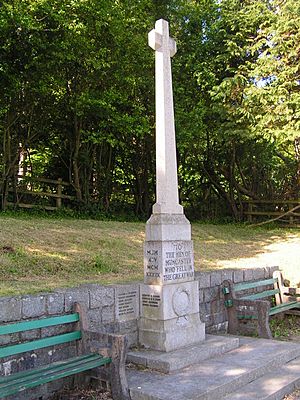Muncaster War Memorial facts for kids
Quick facts for kids Muncaster War Memorial |
|
|---|---|
| United Kingdom | |
 |
|
| For men from Muncaster killed in the First World War | |
| Unveiled | September 1922 |
| Location | 54°21′27″N 3°24′04″W / 54.357594°N 3.401030°W Muncaster, Borough of Copeland, Cumbria
near |
| Designed by | Sir Edwin Lutyens |
|
Listed Building – Grade II
|
|
| Official name | Muncaster War Memorial and area wall |
| Designated | 21 January 1985 |
| Reference no. | 1086636 |
The Muncaster War Memorial is a special monument in Muncaster, a village on the west coast of Cumbria, England. It was built to remember the brave men from Muncaster who lost their lives in the First World War. This memorial was designed by a famous architect named Sir Edwin Lutyens. It was officially revealed in 1922 and is now a Grade II listed building. This means it is an important historical site that is protected.
Contents
Remembering the Past
After the First World War, many memorials were built across Britain. This was because so many people had died in the war. These memorials helped families and communities remember their loved ones.
Sir Edwin Lutyens' Designs
Sir Edwin Lutyens was a very important architect of his time. He designed many famous memorials. One of his most well-known works is The Cenotaph in London. This monument is a national place for remembering those who served. He also designed the Thiepval Memorial to the Missing, which is the largest British war memorial in the world.
Lutyens also created the Stone of Remembrance. You can find these stones in many large cemeteries for soldiers. The Muncaster War Memorial is one of fifteen "War Crosses" that Lutyens designed. They all look quite similar.
How the Memorial Came to Be
Before the war, Lutyens was known for designing large country houses. He often worked for rich families. Many of his war memorial projects came from people he knew before the war. His connection to Muncaster came from Sir John Ramsden of Muncaster Castle. Sir John asked Lutyens to design the war memorial in April 1919.
Design and History
The Muncaster War Memorial stands where the A595 road meets the road to Ravenglass village. It is one of Lutyens' special War Cross designs.
What the Memorial Looks Like
The memorial is made from Lakeland granite. It has a tall, narrow cross shape that gets thinner towards the top. Near the top, there are short arms that are part of the cross.
At the bottom of the cross, there is a rectangular stone base. On this base, you can read the words: "TO THE MEN OF MUNCASTER WHO FELL IN THE GREAT WAR". Below these words, there is a carved laurel wreath. This wreath is a symbol of honor and victory. While Lutyens used wreaths on other memorials, Muncaster's is the only War Cross with one.
Details of the Structure
The whole memorial stands on three shallow stone steps. It is placed inside a special space in a stone wall. The names of the soldiers who died in the First World War are carved into stone panels on this wall. Later, the names of those who died in the Second World War were also added.
Unveiling and Recognition
The memorial was officially revealed in September 1922. A woman named Mrs. Cowan from Ravenglass unveiled it. She had lost three sons in the war.
The Muncaster War Memorial became a Grade II listed building on January 21, 1985. This means it is recognized as a building of special historical interest. In 2015, during the 100th anniversary of the First World War, Lutyens' war memorials were seen as a "national collection." Many of his memorials, including this one, had their protected status reviewed and updated.

